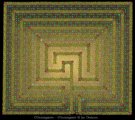D'abord une charmante pincée de mythologie grecque:
Minos de Crète voulait monter sur le trône. Il fit la promesse aux
dieux qu'il sacrifierait le magnifique taureau blanc qui lui était
offert, dans ce but, par Poséidon.
Homme politique qu'il était, il garda le taureau blanc pour soi et
sacrifia une autre bête. Poséidon en fut fort mécontent, et fit tomber
amoureuse du taureau, Pasipha, la femme de Minos. Cela alla si loin que
Dédale (qui comme vous le savez, eut encore d'autres idées sublimes)
dut construire pour Pasipha une vache en bois, dans laquelle elle se
mit à genoux pour séduire le taureau.
Neuf mois plus tard, le roi Minos constatait que son fils était un peu
déformé… Il convoqua Dédale qui, sans doute, poussa un soupir de
soulagement, en apprenant que ce n'était que pour concevoir un
labyrinthe, dans lequel on pourrait enfermer ce monstre à tête et queue
de taureau.
Chaque année, probablement quand il fut plus âgé, on offrit à ce
« Minotaure », neuf vierges. Aucune d’elles ne ressortit
jamais du labyrinthe.
Et il fallut la formidable intelligence d'Ariane, la fille de Minos,
pour concevoir l'idée de fournir au héros grec, Thésée, un fil qu'il
put suivre pour retrouver son chemin, après qu'il eut massacré le fils
handicappé du roi dans son sommeil.
Si on suppose que le labyrinthe de Crète était effectivement un
labyrinthe de type crétois, on peut s’interroger sur les facultés
intellectuelles des protagonistes de cette histoire, car un tel
labyrinthe, aussi sinueux soit-il, n'est composé que d'un seul chemin
conduisant au centre qu'il suffit, évidemment, de suivre à l’envers
pour ressortir.
First a pinch of charming Greek mythology:
Minos of Crete wanted to ascend the throne and promised to sacrifice
the magnificent snow-white bull Poseidon had sent him. But Minos was a
good politician: he kept the white bull for himself and sacrificed
another animal instead. Poseidon's reaction was to make Minos'
wife Pasipha fall madly in love with the bull. It even reached the
point she had Daedalus (who as you know also had some other sublime
ideas) make a wooden cow for her. Pasipha climbed into it and thus
seduced the bull.
Nine months later, king Minos saw his newborn son was somewhat misshapen.
Daedalus was summoned again, and he must have breathed a sigh of relief
when it was but to be ordered to build a labyrinth to lock in this
monster with head and tail of a bull. Every year the 'Minotaur'
(probably a little bit older by then) got seven youths to feast upon.
None of them ever found the way back out of the labyrinth.
And it took the infinite intelligence of Minos' daughter Ariadne to
think up the idea of providing someone - in this case the Greek hero
Theseus - with a thread he could follow on the way back out of the
maze, after he had bashed in the head of the sleeping, deformed royal
son.
If the labyrinth of Crete was indeed, as we safely may presume, a
Cretan labyrinth, we could ask some questions about the intellect of
the protagonists of the above story: even though this kind of labyrinth
is very sinuous, it is made of only one path to the centre and back.



